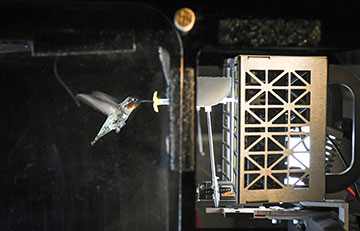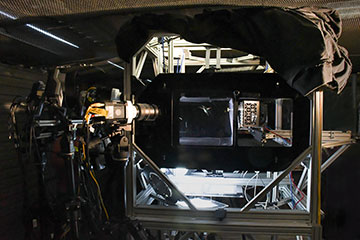
In the experimental setup, a hummingbird hovers by an artificial flower in front of acoustic cameras. [Image: Lentink Lab]
Whether it’s the high-pitch buzz of a mosquito or the signature wing whistle of a mourning dove, birds and insects produce a variety of sounds as they flap their wings—and these differences can be chalked up to a variety of evolutionary mechanisms. For example, feather sonation among pigeons might incite a flock to flee and take flight, while owls suppress their wings’ aerodynamic sound to sneak up on their prey. These adaptations and mechanisms are so diverse, in fact, that it’s not entirely clear just how flapping wings generate their sound.
Now, a team of researchers says it has unraveled this mystery for a bird that is synonymous with the characteristic timbre of its wing sounds—the hummingbird (eLife, doi: 10.7554/eLife.63107).
The U.S.-Netherlands team employed a complex setup of high-speed cameras, pressure plates and microphones to measure the precise biophysical origin of hummingbirds’ wing hum. The team’s idealized acoustic model visualized and interpreted the 3D sound field in detail, accurately predicting the sound that flapping wings radiate, for hummingbirds as well as other birds and insects.
Flight aerodynamics
The aerodynamics of how birds, insects and even planes fly ultimately boils down to the forces of lift and drag, and these forces, the researchers write in eLife, also dictate the various sounds of flapping wings. Most birds fly fairly quietly because they generate most of the lift just once during the wingbeat at the downward stroke. Hummingbirds, on the other hand, generate lift twice per stroke, during both the downward and upward wingbeat, and it’s the lift, the researchers found, that is the primary source of the hum.
The researchers settled on hummingbirds as a model of flapping wing hum, as their flight style shares similarities with those of both birds and insects. Furthermore, they write, “their wing kinematics and unsteady aerodynamic forces are very repeatable during hover,” during which they beat their wings 40 times per second.
Cameras, sensors and microphones—oh my!

A hummingbird hovers within a customized flight chamber, outfitted with high-speed cameras, pressure sensors and microphone arrays. [Image: Lentink Lab]
To visualize this process, the Stanford University, USA, and Eindhoven University of Technology, Netherlands, researchers developed an aerodynamic force platform to directly measure the 3D aerodynamic force created by hovering hummingbirds. They then integrated this data in an aeroacoustics model to predict the sound radiated by flapping wings.
The team began by outfitting a specialized flight chamber with high-speed cameras, pressure sensors and an array of 2,176 microphones. Three high-speed stereo cameras, developed by Eindhoven spinoff company Sorama, allowed the researchers to visualize the sound. To interpret the 3D sound images, the team used high-speed cameras to capture the wing movement frame by frame, while pressure sensors served to record the lift and drag forces generated by the wings.
With terabytes of data in hand, the team then synchronized the information they’d collected—aligning the wing location, the corresponding sound and the pressure differences for each video frame—before employing a custom algorithm to condense everything into a 3D acoustic model.
Circumventing noise pollution
Finally, the researchers used the model to determine how wing flap sounds depend on the frequency content in the oscillating forces of various animals—from mosquitoes and flies to parrotlets—in hovering flight. Using those findings, they determined how the “hum” scales with body mass and flapping frequency for 170 distinct species. Higher harmonic content throughout the wing stroke, they explain in the paper, results in a “buzz,” while equivalent first and second harmonic content makes hummingbirds “hum,” and dominant first harmonic content results in the softer “whoosh” of larger birds.
In future, the researchers plan to apply this research to the increasingly prevalent problem of noise pollution. Visualizing sound in this way could, they say, help make engineered devices like drones and appliances quieter.
